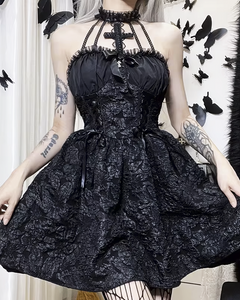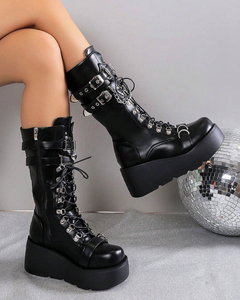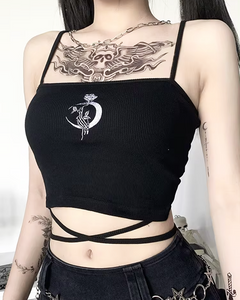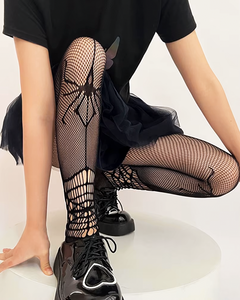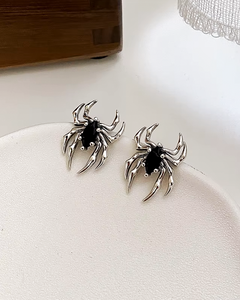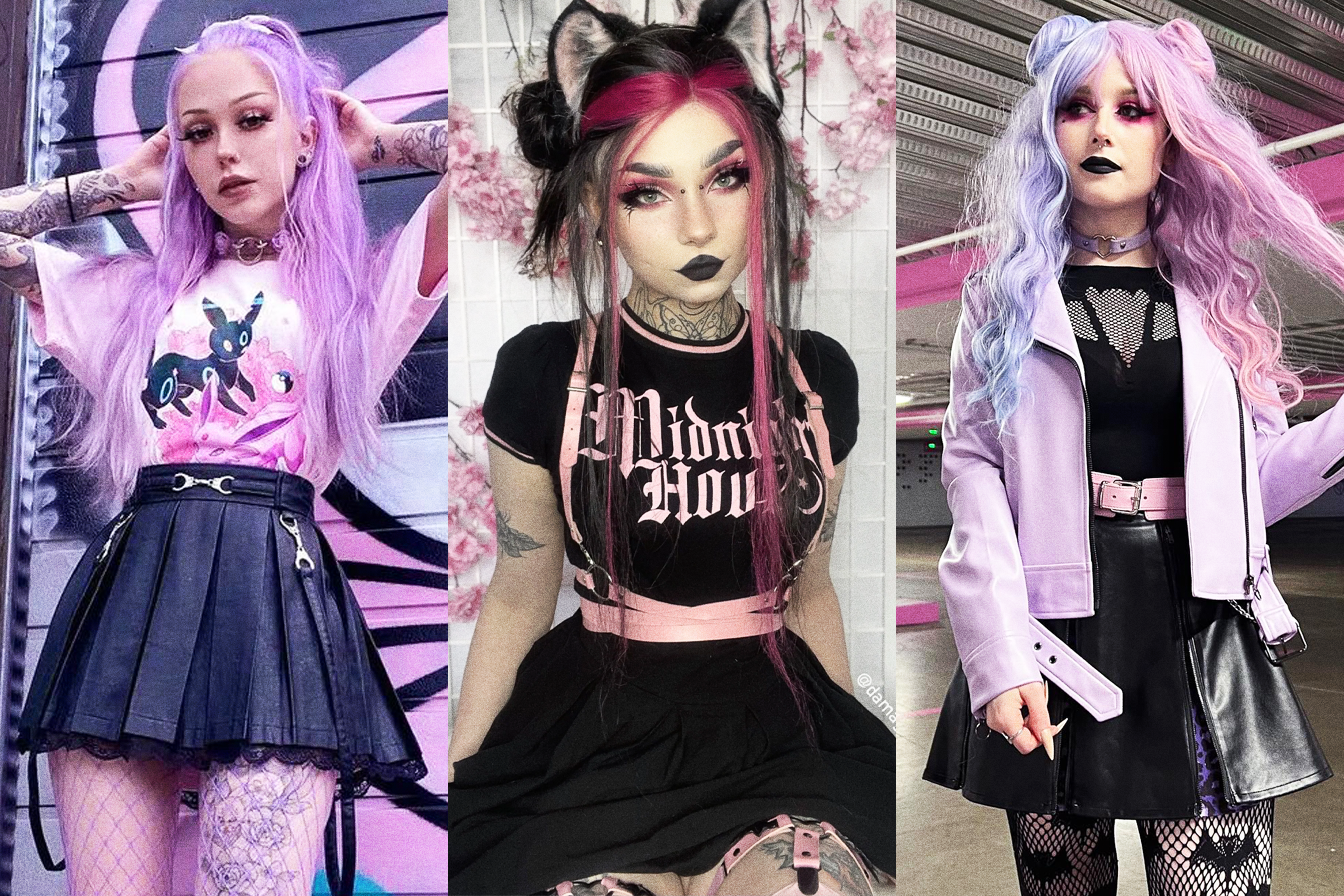Darkness and sweetness aren't supposed to mix — but pastel goth proves otherwise. Imagine lavender hair, black chokers, oversized sweaters with pink skulls, and combat boots paired with unicorn pins. The pastel goth subculture takes the darkness of goth and the cuteness of kawaii and blends them into something uniquely bold and playful. It's not about choosing between the light and the dark; it's about celebrating both at once.
Born from the depths of the early 2010s Internet, pastel goth emerged on Tumblr as a visual rebellion. It reimagined gothic fashion for a new generation raised on anime, pop culture, and irony. Instead of rejecting color, pastel goth embraced it — turning black lace into bubblegum pink and replacing tears with glitter. The result is a hybrid aesthetic that's both eerie and adorable, heavy and soft, ironic and sincere.
Unlike traditional goth, which draws its strength from romantic melancholy and existential depth, pastel goth expresses emotional complexity through contrast. It says, "I'm dark, but I still love rainbows." It's a visual metaphor for modern identity — fragmented, fluid, and self-aware. In short, pastel goth is what happens when you dip the gothic soul in cotton candy.
It's a movement that doesn't take itself too seriously, yet speaks volumes about individuality and expression in the digital age. Pastel goths play with opposites — sweetness and rebellion, pink and black, cute and cursed — and find beauty where contradiction lives.
The Essence of Pastel Goth

Pastel goth is a paradox turned into a fashion statement. It's the visual embodiment of duality: soft pastel tones meet occult symbols, sweetness meets defiance. The style rejects binaries — it's not fully dark, not fully bright. Instead, it thrives in the in-between. A pastel goth outfit might combine a mint-green skirt with a skeleton-print shirt, or a lavender wig with a choker with spikes. It's this collision of innocence and rebellion that gives it power.
Philosophically, pastel goth is about reclaiming the "dark" from the negative. It transforms sadness into something expressive, fear into fun, and individuality into art. The people who embrace it don't just follow a trend — they remix culture, turning gothic symbols into something lighter and more approachable.
The Pastel Goth Style at a Glance
| Aspect | Description |
|---|---|
| Origin | Early 2010s Internet culture (Tumblr, Instagram) |
| Core Elements | Pastel colors mixed with gothic imagery and occult symbols |
| Influences | Goth subculture, Kawaii culture, Harajuku fashion, punk |
| Colors | Lavender, baby pink, mint green, sky blue, with black accents |
| Fashion Icons | Platforms, chokers, skeleton prints, oversized sweaters, dyed hair |
| Philosophy | Turning darkness into something soft, ironic, and expressive |
Origins and Cultural Context

Pastel goth was born on the Internet — specifically on Tumblr — around the early 2010s. At the time, online communities were experimenting with identity, self-expression, and hybrid aesthetics. Users combined gothic imagery with the bright tones of kawaii culture, creating a visual language that felt fresh and subversive. What began as a niche tag soon became a global microtrend, spreading across social platforms and inspiring artists, influencers, and independent brands.
Its roots can be traced back to the merging of Western goth and Japanese street styles like Harajuku, Decora, and Fairy Kei. From Harajuku's playful chaos came the love for color and layering; from goth came the fascination with the dark, the occult, and the mysterious. The two collided to create something that felt rebellious yet approachable, edgy yet cute.
Unlike traditional goth, which grew from post-punk music and underground scenes, pastel goth evolved entirely online. It was visual first, musical second — built through images, art, and fashion rather than clubs or concerts. In that sense, it reflects the digital generation's way of building identity: remixing and reinventing rather than adhering to a single origin story.
By the mid-2010s, pastel goth had evolved into an aesthetic movement of its own, influencing everything from makeup tutorials to digital art. Its appeal lay in its contradictions — it felt simultaneously dark and comforting, rebellious and cute. It allowed people to explore self-expression without fitting into rigid boxes, embodying the Internet's spirit of creative chaos.
Fashion: The Aesthetic of Contrast
The heart of pastel goth lies in how it looks — a fusion of softness and edge. Pastel goth fashion borrows the darkness of goth but bathes it in candy-colored light. Outfits often mix baby pink with black leather, or mint green with chains and spikes. Common motifs include skulls, inverted crosses, bats, pentagrams, and skeletons — all reimagined in pastel hues. The goal isn't to shock, but to subvert expectations.
Typical pastel goth outfits might feature an oversized lavender hoodie with a pentagram design, paired with a plaid skirt, goth fishnet tights, and platform boots. Accessories often play a big role — chokers, oversized bows, creepy-cute jewelry, and plush backpacks shaped like coffins or hearts. Makeup is dramatic but playful: pale foundation, thick eyeliner, pink blush, and pastel lipstick that looks both doll-like and eerie.
Hair color is also central to the aesthetic. Many pastel goths dye their hair lilac, mint, or silver, sometimes blending in darker roots for a grunge touch. This mix of decay and candy tones captures the essence of the style — decay wrapped in sweetness. It's not about pretending to be dark or cute; it's about embracing both sides and making them coexist beautifully.
DIY culture plays a huge role. Many pastel goths customize their own clothes, combining thrifted goth pieces with pastel fabrics, patches, and pins. The result is deeply personal — every outfit tells a story. The style thrives on individuality and experimentation rather than perfection.
Symbolism and Mindset: Soft Darkness

Pastel goth is not just a fashion style — it's a state of mind. It's about embracing contradiction and rejecting labels. It takes traditional gothic themes — death, sadness, rebellion — and reframes them through a lens of humor and softness. The pastel goth philosophy says: you can love the macabre and still smile about it. You can wear skulls and still paint them pink.
This mindset reflects the postmodern attitude of the 2010s Internet generation. In a world saturated with images and irony, pastel goth reclaims sincerity through playfulness. It's about being dark without despair, cute without conformity. For many, it's also a way to reclaim power — especially for those who felt excluded from traditional goth's rigid standards or gendered expectations.
Feminism and queer culture also play a large role in pastel goth's identity. The style often subverts gender norms by mixing delicate and aggressive elements. Spikes and lace coexist, softness becomes armor, and vulnerability turns into strength. It's a reminder that identity is fluid — and beauty doesn't have to fit one mood or color palette.
In short, pastel goth's philosophy is one of duality. It's the acceptance that you can be both fragile and fierce, broken and beautiful, and that those things are not contradictions — they're complements.
Influence on Music, Art, and Internet Culture
Although pastel goth didn't start as a music-based subculture, it has influenced and been influenced by alternative artists with similar aesthetics. Singers like Melanie Martinez, Poppy, and Grimes embodied the pastel goth spirit — combining dark lyrical themes with sugary visuals. Their music videos, fashion, and personas echoed the same message: innocence can be unsettling, and darkness can be sweet.
Pastel goth has also flourished in digital art and fashion illustration. Artists on Tumblr and Instagram helped define the aesthetic by sharing drawings of pastel skeletons, haunted dolls, and cute monsters. Independent fashion labels began producing pastel chokers, skeleton sweaters, and kawaii goth jewelry, solidifying the style as a global trend.
Beyond aesthetics, pastel goth paved the way for newer online movements like e-girl, soft grunge, and dreamcore. It taught digital culture how to blend irony, sincerity, and self-expression into one identity. On platforms like TikTok, pastel goth continues to evolve — less as a strict style and more as a creative mood, a visual language of contradiction that still resonates today.
Conclusion
Pastel goth is more than pastel hair and black chokers — it's a cultural reflection of how beauty, irony, and emotion can coexist. It's about contrast, creativity, and the freedom to mix worlds that were never meant to meet. In its own playful way, pastel goth challenges the idea that darkness has to be heavy or serious.
It's an aesthetic for those who live between extremes — for dreamers who love pink but still find comfort in shadows. It's fashion as a form of irony, rebellion, and tenderness all at once. Like its colors, it's complex, layered, and ever-changing.
In the end, pastel goth proves one thing: darkness doesn't have to be black. Sometimes, it wears pink.


